A gentle and safe exercise routine prepared for pregnant women, with specific sessions designed for each trimester of pregnancy. These yoga sessions are planned to help expecting mothers adapt to the changes in their body that come with pregnancy while building strength and flexibility required for childbirth. It is important to note that consult a doctor before starting these sessions.
Table of Contents
WHAT IS YOGA?
Yoga is an ancient Hindu practice that unites the body and soul, aiming to attain inner peace and overall well-being. It is based on the principle of physical and mental balance. yoga is not just a form of exercise; it is a holistic approach to harmonizing the body and mind. A person who practices yoga with dedication is called a yogi or yogini, signifying a commitment to a philosophy that seeks balance, both physically and mentally. Through physical exercises, yoga strengthens and tones the body, enhancing flexibility, strength, and balance. Simultaneously, mental exercises in yoga promote mental well-being, reducing stress and anxiety.
Also Read: What Is Hatha Yoga? Its Benefits, Spiritual Benefits, How To Practice
WHAT IS PRENATAL YOGA?

Prenatal yoga is a sacred and gentle practice specifically designed to honor the journey of pregnancy. Established in the ancient wisdom of yoga, it recognizes the intense transformation a woman undergoes during this time and seeks to support her physical, mental, and spiritual well-being. Prenatal yoga embraces the divine feminine energy within, fostering a deep connection between the mother and her growing child. This practice involves asanas modified to accommodate the changes in the pregnant body, promoting strength, flexibility, and balance.
Prenatal yoga honors the sacred life within, nurturing a peaceful environment for both mother and baby. It serves as a sanctuary of serenity, fostering a sense of empowerment, mindfulness, and connection with the divine creation unfolding within. In this yogic journey, women embark on a path of self-discovery and self-care, embracing the transformative power of pregnancy while preparing for the sacred act of childbirth.
BENEFITS OF DOING PRENATAL YOGA
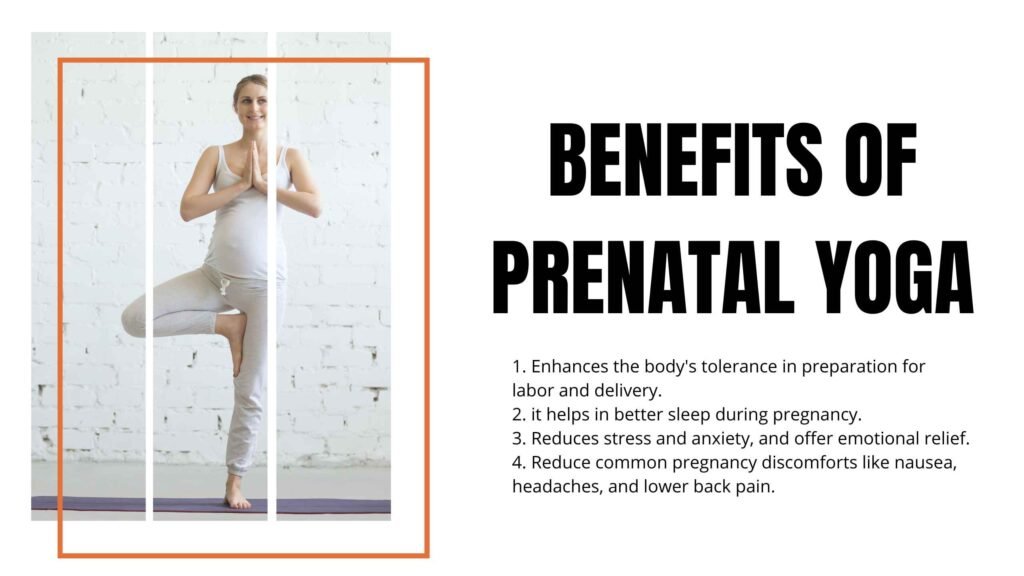
Among its numerous benefits, prenatal yoga helps lower blood pressure, reduces the risk of preterm labor, and alleviates stress on the body. It even plays a role in reducing the chances of miscarriage and effectively managing a high heart rate. This practice significantly decreases the occurrence of pregnancy-induced hypertension and aids in mood stabilization, fighting off depression through meditation and specialized breathing techniques.
It supports the body’s adaptation to the rapid changes experienced during pregnancy and fosters a deep connection between the mother and her baby. Additionally, it aids in combating common sleep issues, promoting overall well-being for the mother and a healthy start for the baby.
- Enhances the body’s tolerance in preparation for labor and delivery.
- it helps in better sleep during pregnancy.
- Reduces stress and anxiety, and offer emotional relief.
- Reduce common pregnancy discomforts like nausea, headaches, and lower back pain.
Please remember to take medical advice from your healthcare provider before engaging in these yoga sessions for a safe and healthy pregnancy experience.
WHEN YOU SHOULD START PRENATAL YOGA?
you should start prenatal yoga as soon as you feel comfortable and have received approval from your healthcare provider, typically after the first trimester. Listen to your body’s signals and begin when you feel ready. Prenatal yoga can support you throughout your pregnancy journey, helping you stay physically and mentally balanced as you nurture the divine along with the unborn. It’s a practice that honors the sacredness of pregnancy, fostering strength, flexibility, and inner peace, all of which are beneficial for both you and your baby. Remember to consult your healthcare provider to ensure it’s safe for your unique pregnancy circumstances, and find a qualified prenatal yoga instructor who can guide you on this beautiful journey.
PRENATAL YOGA FOR BEGINNERS

Prenatal yoga for beginners, is a gentle and nurturing practice specially crafted to support expectant mothers who are new to yoga. It honors the divine journey of pregnancy. Start with the basics of breath awareness. Inhale deeply through your nose, filling your lungs with life-giving prana (energy), and exhale slowly through your mouth, releasing any tension. Simple stretches and poses help you build strength and flexibility while promoting relaxation. Practice mindfulness in your movements.
HOW EFFECTIVELY CAN WE DO YOGA AT HOME?
Your body knows best. If a pose feels painful or too challenging, modify it or skip it. It’s about nurturing and healing. Begin with basic poses like Child’s Pose, Downward-Facing Dog, or Mountain Pose. These poses are foundational and help you build strength, flexibility, and balance. Pay attention to your breath. Yoga is not just about physical postures but also about mindful breathing. Inhale deeply through your nose and exhale slowly through your mouth. Prenatal yoga is healthy for both mother and child, and it promise make delivery m56ore easy and a quick bounce back to shape after birth.
WHO CAN DO PRENATAL YOGA?
Prenatal yoga is designed specifically for pregnant women and can be practiced by most expectant mothers, but it’s important to consider individual circumstances and consult with a healthcare provider before starting any new exercise routine during pregnancy.
WHO SHOULD AVOID PRENATAL YOGA?
While prenatal yoga is generally safe and beneficial for most pregnant women, there are some situations where caution is necessary, and it’s best to avoid it.
If you are pregnant and experiencing vaginal bleeding or other pregnancy complications, like placenta problems, it’s crucial to avoid prenatal yoga. If you already know that your pregnancy may lead to a complicated labor, it’s wise to refrain from prenatal yoga.
If you have pre-existing health conditions that affect your pregnancy and If you have recently experienced a miscarriage or a forceful abortion, it’s essential to give your body time to heal naturally and emotionally. Prenatal yoga can be physically and emotionally demanding, so it’s not advisable right after such traumatic experiences.
LIST OF BEST PRENATAL YOGA
Specific prenatal yoga poses help one benefit the maximum from it, and all of them are mentioned below in a stepwise manner. This allows one to understand the intensity of prenatal yoga along with its basics.
Easy pose

“Easy Pose” or “Sukhasana,” and it’s a simple yet powerful posture that offers many benefits during pregnancy stress and Anxiety Relief, it is excellent for opening up the hip region. During pregnancy, your hips can become tight, and this pose helps keep them flexible also it helps in lower Back Pain Relief.
Sit on a yoga mat with your legs crossed, place your feet so that the soles are facing upward and your knees are wide apart, forming a triangle shape. Keep your back straight but relaxed.
Rest your hands on your knees, with your palms facing upward. This hand position is called “Mudra” and is known for creating a sense of openness and receptivity. Breathe deeply and comfortably, holding this posture as long as it feels comfortable for you.
KONASANA-II (STANDING SIDE STRETCH)

Konasana-II, or Standing Side Stretch, is a yoga pose where you stand with your feet away from each other, reach your arms over your head, and gently bend to one side, and create a stretching sensation to that side. It’s a simple and effective way to promote better posture and overall body comfort. Konasana-II is excellent for improving flexibility in your sides and waist, relieving tension, and promoting good posture. Remember to go gently and not push yourself too far, especially if you’re new to yoga or stretching exercises
CAT-COW POSE

Begin on your hands and knees, like a four-legged animal. Your hands should be directly under your shoulders, and your knees should be under your hips.
Inhale deeply as you arch your back downward, raising your butt and lifting your head. Imagine making a curve like a cow’s back. Hold this position for a few seconds as you breathe in.
Exhale slowly as you round your back upward, tucking your chin toward your chest. Imagine making a curve like a scared cat. This is the cat part of the pose.
Keep alternating between the cow and cat positions, inhaling as you arch down and exhaling as you round up. Move slowly and gently, focusing on your breath and the movement of your spine.
Repeat this movement in sets of five, with no breaks in between. It helps relieve tension in your shoulders, opens up your hips, and reduces pressure on your belly. Plus, it prepares your body and back for the birthing process.
WIDE KNEE CHILD’S POSE

Child’s Pose is a valuable yoga position for mothers and baby’s both physical and mental benefits during pregnancy. It effectively relieves pressure on the growing belly, eases back pain, and widens the hips, contributing to increased comfort. To practice the Child’s Pose, start by kneeling on a soft yoga mat with knees hip-width apart and big toes touching. Gradually lower your buttocks towards your heels, extending your arms forward.
Your chest and forehead should rest comfortably on the mat, creating a relaxed posture. You can choose to place your palms facing down beside your head or extend your arms backward along your thighs for added comfort. Spend about 5 minutes or more in this soothing pose, focusing on your breath and allowing your body and mind to unwind. To exit the pose, gently lift your torso and return to a seated position on your heels.
YOGA SQUAT

The Yoga Squat is a highly beneficial prenatal yoga pose that helps relieve hip tightness and prepares the pelvis for childbirth. It primarily targets the belly, hips, and pelvis, offering several advantages for expectant mothers. To perform this pose, start by sitting on the floor with your legs spread out. Gently bend your knees, bringing your feet closer to your buttocks. Then, position your knees slightly wider than your shoulders. Shift your weight onto your feet by lifting your buttocks off the ground and hold this position for several seconds, depending on your fitness level. For added support, you can use a stool or block to sit on.
BUTTERFLY POSE
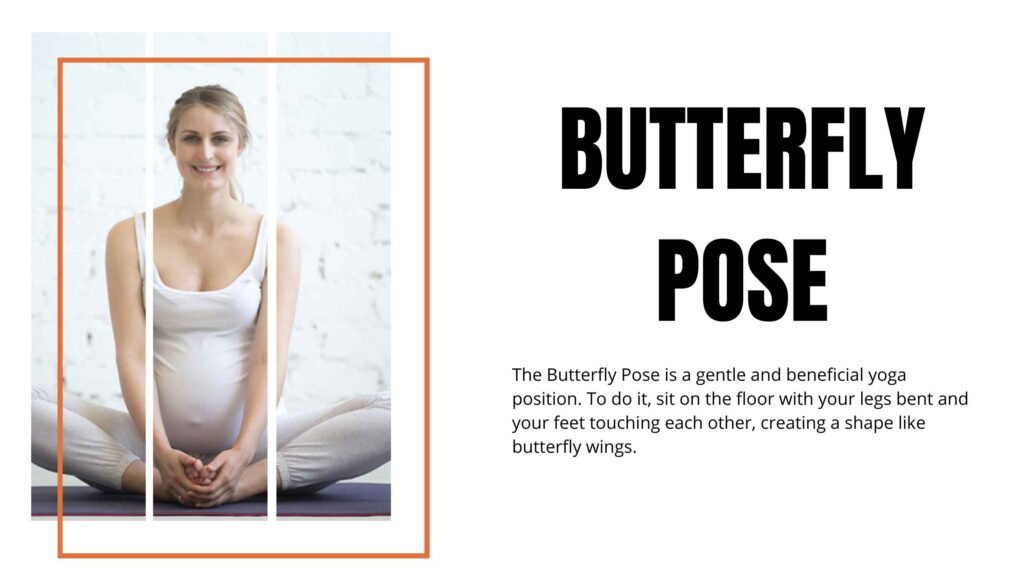
The Butterfly Pose is a gentle and beneficial yoga position. To do it, sit on the floor with your legs bent and your feet touching each other, creating a shape like butterfly wings. Hold your feet with your hands, and gently flap your knees up and down, resembling a butterfly’s wings. This pose helps open up the hips and stretch the inner thighs, promoting flexibility and comfort. It’s a simple and relaxing pose that can be especially helpful during pregnancy to ease tension and discomfort in the hip and groin area.
WARRIOR POSE
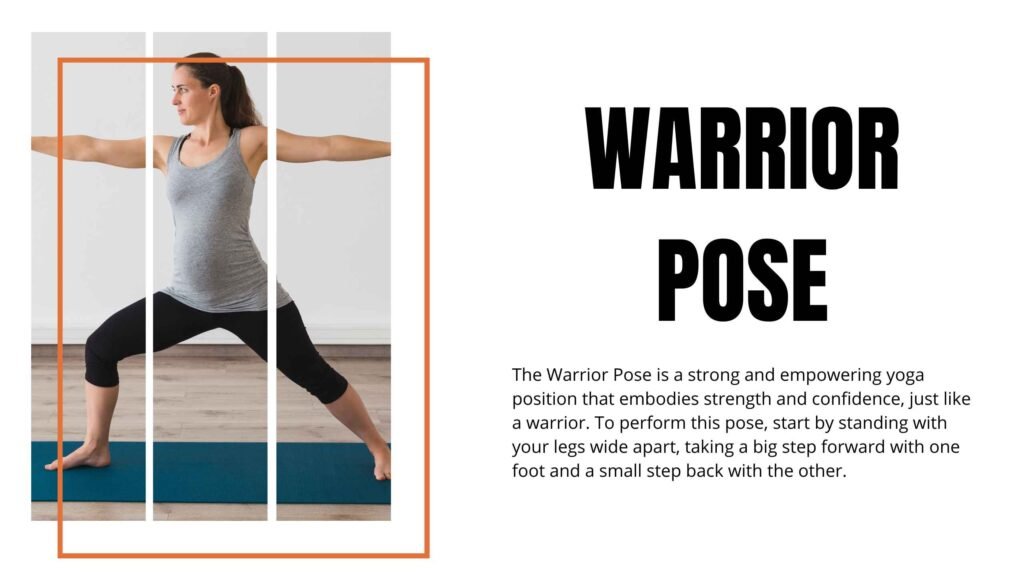
The Warrior Pose is a strong and empowering yoga position that embodies strength and confidence, just like a warrior. To perform this pose, start by standing with your legs wide apart, taking a big step forward with one foot and a small step back with the other. Bend your front knee at a 90-degree angle while keeping the back leg straight. As you do this, stretch your arms out to the sides, forming a T shape with your body.
This pose is not just about physical strength; it also builds mental stamina and makes you feel grounded and powerful. It’s like summoning your inner warrior. Warrior Pose is particularly effective for toning your leg muscles and enhancing balance. It’s a wonderful way to boost your self-assurance and determination while also improving your overall physical strength. It’s a pose that combines both physical and mental aspects, helping you feel more powerful and confident in your practice.
CORPSE POSE
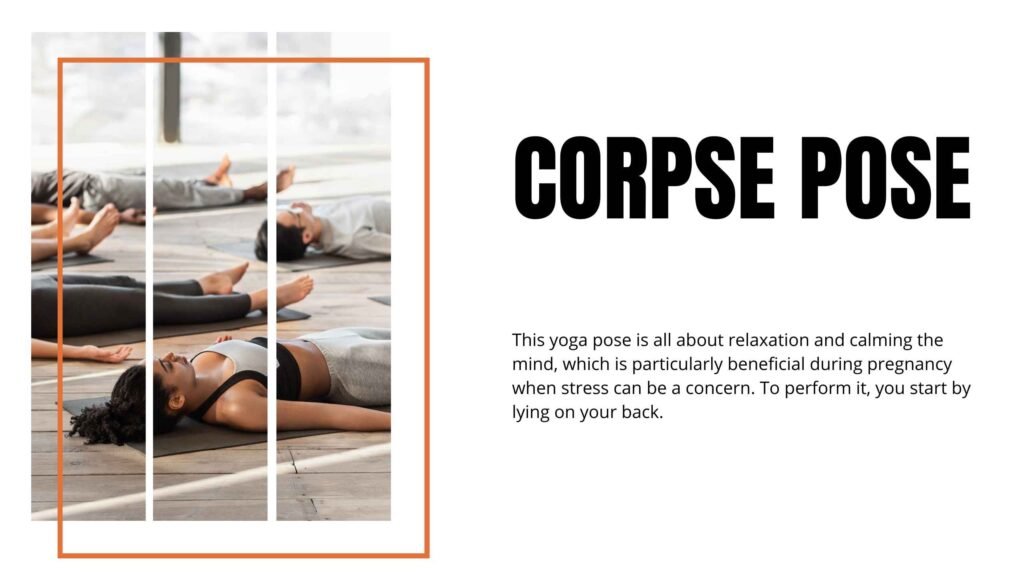
This yoga pose is all about relaxation and calming the mind, which is particularly beneficial during pregnancy when stress can be a concern. To perform it, you start by lying on your back. To ensure your comfort, you can place a pillow under your head, knees, and legs. If you like, you can also use a pillow under your belly for added support. In this pose, you simply lie down and let go of any tension. Hold this soothing posture for at least 5 minutes, or even longer if it feels good.
The beauty of this practice lies in its ability to create a deep sense of calm and mental relaxation. It’s like giving your mind a gentle break, allowing you to find peace and tranquility during pregnancy.
DISADVANTAGES OF DOING PRENATAL YOGA
Prenatal yoga is generally considered safe without any reported disadvantages or side effects. However, it’s crucial to follow specific guidelines for each trimester to ensure safety. During the first, second, and third trimesters, variations in poses and stretches are recommended to accommodate the changing body.
There are some important dos and don’ts to keep in mind when practicing prenatal yoga. Always use a yoga mat for a secure grip during stretches and poses to prevent injuries. Ensure the yoga space is well-ventilated for proper air circulation. Each session should conclude with meditation for relaxation. Stay adequately hydrated while performing yoga to support your body. Opt for comfortable, loose-fitting clothing that allows for easy movement during asanas.
THINGS REQUIRED TO DO PRENATAL YOGA IF YOU ARE AT HOME & GYM?
To practice prenatal yoga, whether at home or in a gym, you’ll need a few essential items: a gym mat for a comfortable surface, a water bottle to stay hydrated, a hand towel for sweat, comfortable yoga attire that allows easy movement, a yoga block for support, pillows or cushions for added comfort, and a meditation CD to enhance relaxation and reduce stress during your practice. These items will help you create a safe and enjoyable prenatal yoga experience.
PRENATAL YOGA CLASSES
Prenatal yoga classes are specially designed yoga sessions for expectant mothers. These classes focus on gentle exercises and stretches that cater to the unique needs and changing bodies of pregnant women. Prenatal yoga provides numerous benefits, including reducing stress, improving flexibility, and strengthening muscles that are important during pregnancy and childbirth. In these classes, certified instructors guide participants through a series of poses, emphasizing proper alignment and breathing techniques. It’s not only a physical practice but also a supportive community where pregnant women can connect, share experiences, and prepare both their bodies and minds for the journey of motherhood. These classes are typically safe and welcoming spaces for moms-to-be to stay active and promote overall well-being during pregnancy.

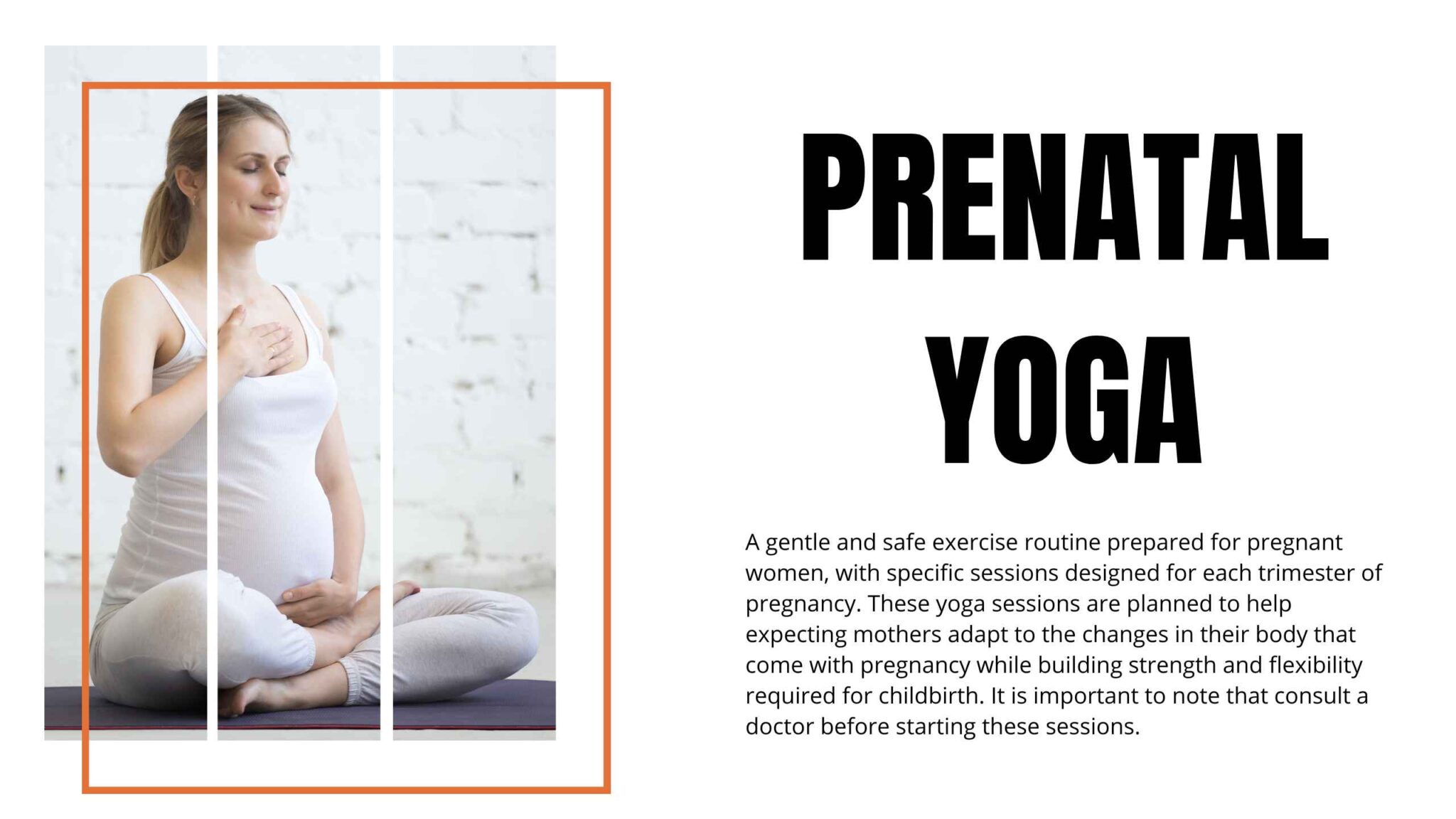







This post is extremely radiant. I really like this post. It is outstanding amongst other posts that I’ve read in quite a while. Much obliged for this better than average post. I truly value it!